For anyone using a lower limb prosthetic, nothing matters more than the socket. It may not be the most visible part of the device, but it’s the part you feel every single moment. It’s the bridge between your body and your prosthetic leg—and how it’s designed makes all the difference.
The socket is where your weight is carried, your movement begins, and your comfort is decided. If it fits well and distributes pressure evenly, walking feels smooth. If it doesn’t, even standing can be painful. That’s why understanding socket design isn’t just for prosthetists. It’s for anyone who uses or supports someone with a prosthetic leg.

Why the Socket Is the Heart of the Prosthetic
The Role of the Socket in Everyday Movement
When someone loses a limb, the prosthetic becomes their new support system. But it’s the socket—the part that wraps around the residual limb—that really carries the weight. This is where pressure is transferred, balance is maintained, and movement begins.
If the socket isn’t designed properly, even the most advanced prosthetic leg will feel wrong. Users might limp, lean to one side, or experience pain.
The socket is the one part of the prosthetic that’s in constant contact with the body. So, every small detail—its shape, its materials, how it grips or releases pressure—affects comfort and stability.
Unlike other parts of the prosthetic that can be off-the-shelf, the socket must be tailored. It needs to match the person’s limb perfectly. Because everyone’s limb is shaped differently, there is no universal design that works for all.
A few extra millimeters in the wrong place can create a pressure point. A small gap can lead to rubbing and skin breakdown. That’s why the socket is not just another component—it’s the foundation of comfort and mobility.
How Weight Is Transferred Through the Socket
When you stand on two legs, your bones carry your weight down to your feet. With a prosthetic leg, that weight has to move from your body into the prosthetic—and it does this through the socket.
The socket sits over soft tissue, bone, and muscle. These areas were never meant to carry all your body weight, so the design must be smart.
If pressure is placed on bony areas, it can cause pain or skin damage. If too much weight is placed on soft tissue, it can lead to swelling or bruising.
A well-designed socket spreads this weight evenly. It avoids pressure on sensitive areas and uses stronger areas—like tendons or muscle groups—to absorb the load.
This distribution is what makes standing feel natural and walking feel smooth. When weight is balanced, you don’t have to think about every step.
The prosthetic works with your body, not against it. That’s why socket design is a careful blend of science, engineering, and experience.
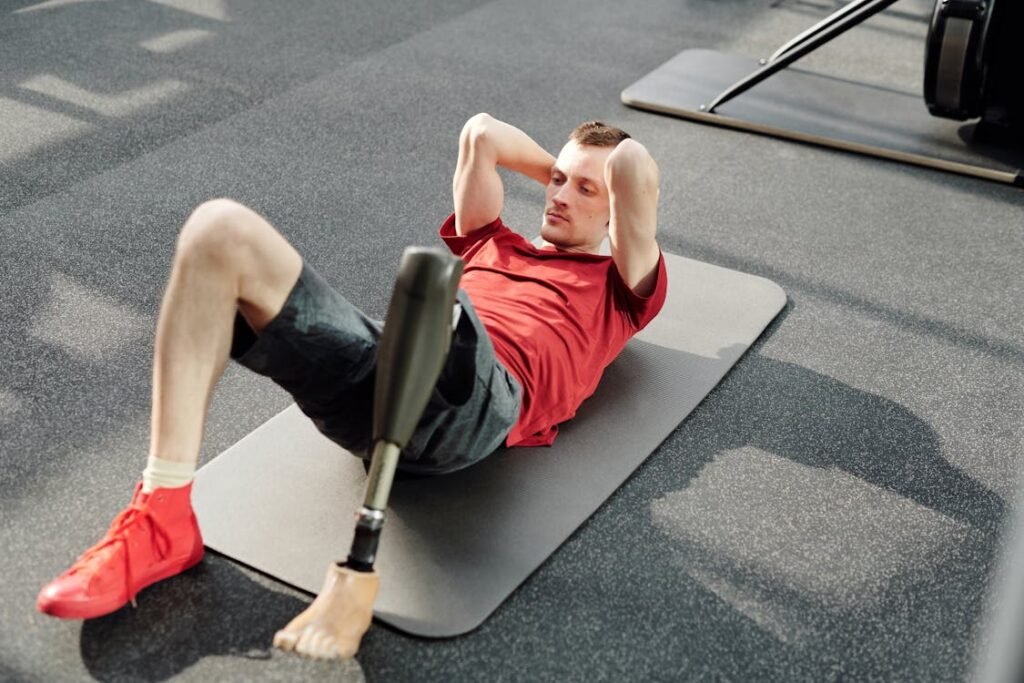
Types of Socket Designs and How They Affect Comfort
Traditional Designs vs. Modern Approaches
In the past, most socket designs focused on placing weight on certain “tolerant” areas of the limb. These were places where the body could handle more pressure, like the patellar tendon or the sides of the residual limb.
This style worked, but it wasn’t always comfortable. It relied on avoiding pain rather than creating full support.
Modern sockets use a different approach. Instead of just using a few pressure points, they aim to spread the weight across the whole surface of the limb.
This is known as total surface bearing. It reduces pressure in any single spot and makes the socket feel more secure. With this design, users often say the prosthetic feels like a part of their body.
Another change in modern design is the use of flexible inner layers. These inner sockets mold to the shape of the limb more closely, while a rigid outer shell provides support.
This flexibility allows the socket to respond to movement, muscle shifts, or even slight swelling during the day.
At Robobionics, we design each socket based on the user’s body, lifestyle, and goals. We use scanning and pressure mapping to understand how their limb handles force. This lets us create a socket that offers stability, reduces pressure points, and fits like a second skin.
Below-Knee vs. Above-Knee Socket Designs
Socket design also depends on the level of amputation. A below-knee (transtibial) socket must support the tibia, calf muscles, and knee.
This type of socket needs to manage both front and back pressure and allow the user to bend the knee comfortably.
An above-knee (transfemoral) socket is even more complex. It has to support the thigh and hip while controlling a mechanical or computerized knee joint.
If this socket doesn’t fit correctly, walking can feel unstable. The user might feel like they’re about to fall or might avoid putting weight on the prosthetic at all.
Because the hip plays a bigger role in movement at this level, above-knee sockets are shaped to allow free hip motion while still gripping securely.
Some newer designs even use suction or vacuum seals to keep the socket tightly in place. This helps with weight-bearing and reduces movement inside the socket, which can cause blisters or irritation.
Proper socket design makes it easier to stand up straight, walk smoothly, and stay balanced—even on stairs or uneven ground.
It supports the body in motion, whether you’re walking across your home or heading out for a full day of work.
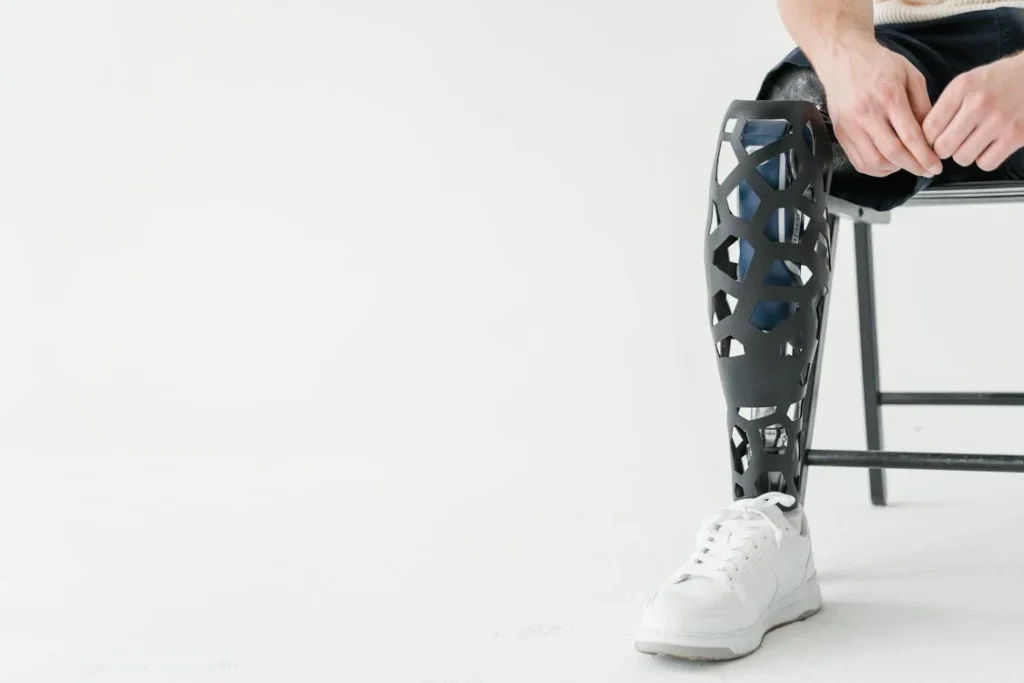
The Power of a Proper Fit
Why Fit Is More Than Just Size
Many people think of a socket like a shoe—just find the right size and it’ll work. But socket fit is more like a second layer of skin.
It doesn’t just need to be the right size—it needs to match the shape of the limb, hug it evenly, and respond to how that limb moves, swells, or shifts throughout the day.
A socket that’s too tight can cut off circulation or create hot spots. A socket that’s too loose can cause friction, sliding, or instability.
Even small changes in fit—just a few millimeters—can lead to discomfort, fatigue, or uneven walking.
That’s why socket fitting is such a detailed process. It’s not just measuring with a tape. At Robobionics, we use 3D scanning and pressure mapping to study how the limb reacts to pressure in real time.
We look at how the user stands, walks, and even sits, because movement changes everything.
If a person favors one side, that needs to be considered. If their limb changes size during the day, we might include adjustable features or liners that adapt to swelling. Fit is not a one-time decision—it’s something we refine over time.
Pressure Distribution and Comfort
Inside the socket, your limb presses against the inner surface with every step. Some areas press harder, while others might not touch at all.
If the design allows pressure to build in the wrong places—like over sharp bone edges or scars—pain and skin damage can follow.
A great socket spreads the load evenly. It uses muscle and soft tissue to cushion the body and avoids known “pressure-sensitive” areas like the tibial crest or fibular head in below-knee amputees.
By doing this, users feel more stable, can walk longer, and are less likely to remove their prosthetic due to discomfort.
This even pressure also helps improve blood flow. When certain parts of the limb are over-compressed, circulation drops.
That can lead to coldness, numbness, or swelling. A good design allows for consistent contact without crushing.
Proper weight distribution doesn’t just protect the skin. It helps with posture. When users feel stable in their socket, they stand straighter, walk more evenly, and use less energy.
Over time, this protects the joints in the back, hips, and remaining limb.
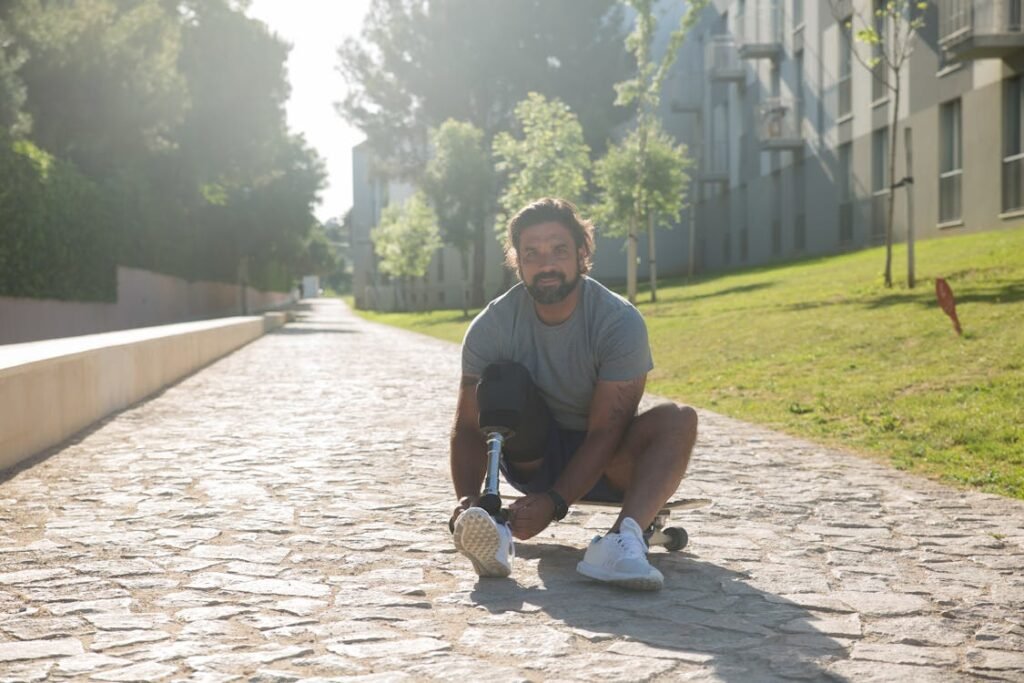
How Alignment Shapes Comfort and Efficiency
Static vs. Dynamic Alignment
Socket design doesn’t stop with the shape—it’s also about how it aligns with the rest of the prosthetic limb.
Alignment means how the socket is positioned in relation to the knee, foot, and ground. This affects balance, stride length, and energy use.
There are two types of alignment: static and dynamic.
Static alignment is how the prosthetic looks and feels when you’re standing still. Is the foot flat on the floor? Is the knee in the right place? Is your body upright without tilting?
Dynamic alignment is how everything works when you start walking. Are your steps smooth? Do you feel pressure shifting evenly? Do you need to overcompensate with your back or hip?
Even a well-made socket will feel wrong if it’s not aligned correctly. A socket that’s too far forward or backward can make you feel off balance.
A slight inward tilt might cause knee pain. That’s why alignment is just as important as socket fit—and why it often takes several trials to get it just right.
At Robobionics, we perform gait assessments during the alignment process. We watch how users move and use fine-tuning tools to adjust angles by tiny degrees.
These adjustments can change the entire walking experience—from feeling awkward to feeling natural.
When the Body Compensates for Bad Alignment
The body is smart. If the prosthetic doesn’t work perfectly, the body finds ways to keep going. But these adjustments often lead to new problems.
Users may lean on their sound leg, swing the prosthetic leg around to avoid tripping, or twist their hips unnaturally to gain momentum.
Over time, these habits lead to strain. Pain may start in the lower back, opposite knee, or even the neck. This discomfort can discourage prosthetic use, or limit how far a person is willing to walk.
Many users don’t even realize they’ve developed these habits until a better alignment shows them how smooth walking can feel.
When the socket is aligned correctly, the prosthetic works with the body’s natural rhythm instead of against it. Steps become more efficient. Users stop leaning or limping. The entire body relaxes into the movement.
This is why follow-up appointments are so important. A socket that worked well a month ago may feel different today due to small posture shifts, changes in weight, or new activity levels.
Real comfort comes from staying in tune with the body—and making regular adjustments when needed.
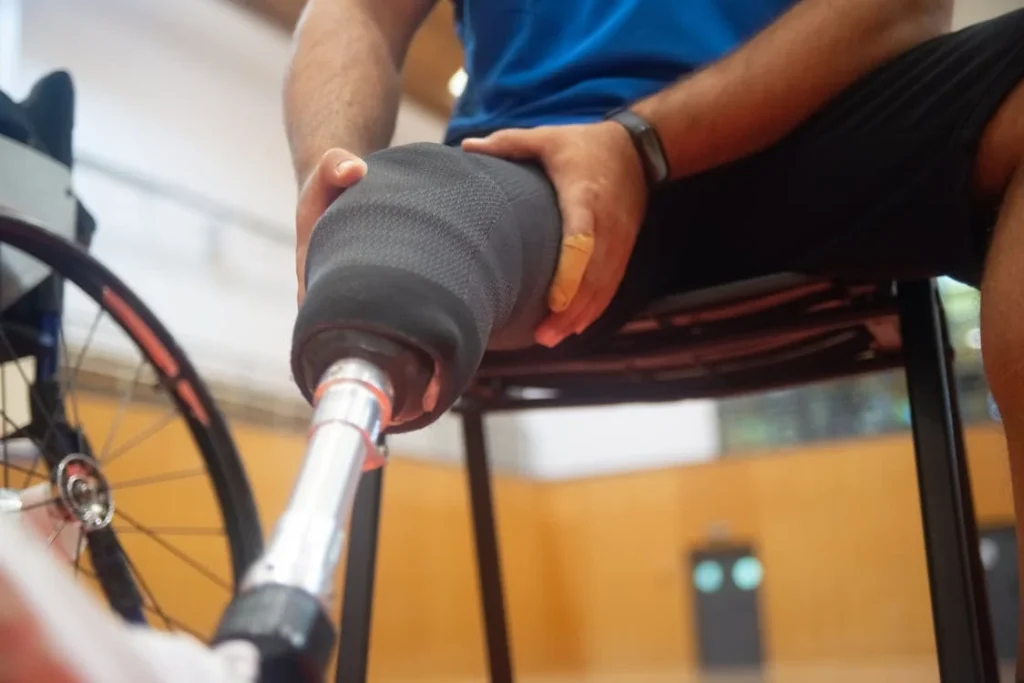
Adapting Socket Design to Real Life
The Impact of Daily Activities on Comfort
Everyday life puts the socket to the test. Sitting, standing, walking, bending—each movement shifts pressure across different parts of the limb.
A socket that feels fine during a short clinic visit may feel uncomfortable after a long day at work, during a grocery run, or after climbing stairs.
Different activities place pressure in different areas. Walking at a slow pace mostly loads the heel and back of the limb. But running or climbing stairs transfers weight to the front or sides.
If the socket design doesn’t allow for this range of motion and pressure, it can lead to sore spots or fatigue.
Even sitting can be a challenge. For above-knee users, the socket must allow the hip to bend comfortably. If the edge of the socket presses into the thigh, it causes discomfort or cuts off circulation.
Some socket designs include cutouts or softer materials in these bending zones. Others use flexible inner linings that move with the body.
At Robobionics, we always ask: “What does your day look like?” A socket built for someone who walks occasionally is very different from one built for someone on their feet all day.
That’s why we don’t take a one-size-fits-all approach. Each socket is crafted for how you live—not just how you walk.
Skin Changes and Limb Volume Fluctuations
The human body is never static. Limb volume changes throughout the day due to activity, hydration, temperature, or overall health. Swelling can make a snug socket feel tight.
Weight loss might create gaps. These small shifts can make a big difference in how weight is distributed through the socket.
That’s why many sockets are paired with soft liners, socks, or adjustable systems that help maintain fit. Users can add or remove layers to account for swelling. This helps keep the limb centered in the socket and prevents uneven pressure.
But even with these tools, the socket must be designed with flexibility in mind. The inner walls should have a bit of “give” to respond to small volume changes.
Certain areas may need to be contoured more deeply to avoid sliding, while other areas are cushioned to prevent overloading.
When we build a socket at Robobionics, we plan for these changes. We design for both the present and the near future—so users can stay comfortable even as their body adapts or heals.
We also provide regular reviews, because the best way to keep a prosthetic working well is to check in and adjust over time.
Skin Health Is a Window Into Socket Fit
If your skin is breaking down, your socket needs to be looked at. Skin health is often the first sign that weight is being carried incorrectly.
Redness, blisters, hard calluses, or open wounds all point to pressure imbalance, poor friction control, or unstable fit.
These issues can happen slowly—one small pressure point that becomes a sore. Or they can happen suddenly—after a long walk or a hot day. Either way, the body is telling you something is off.
Modern sockets are designed to protect the skin, not challenge it. They use breathable materials, soft liners, and smooth inner surfaces. But even the best material won’t help if the socket doesn’t fit right.
We advise all users to inspect their skin daily, especially in high-pressure areas like the shin, patella, or distal end. If something doesn’t feel right, don’t wait.
At Robobionics, we often make small adjustments—shaving down a tight area, adding cushioning, or modifying the angle—that relieve pressure and improve blood flow. The sooner it’s addressed, the faster healing happens.
Psychological Comfort and Confidence
Feeling Safe Affects How You Move
Comfort isn’t just about the skin or bones. It’s also about the mind. Many new users feel unsure about fully trusting their socket.
They worry about slipping, tipping, or whether the limb will stay in place. This mental stress causes people to walk stiffly, shorten their stride, or rely too much on walking aids.
A good socket gives the user confidence. It hugs the limb securely. It moves with the body. It responds to motion without shifting or rubbing.
When users feel that their prosthetic is part of them—not a separate object—they begin to move more naturally.
That trust grows with use. The more steps taken without discomfort, the more the user begins to relax. Over time, their gait improves, their energy use goes down, and their daily confidence increases.
We’ve seen this transformation at Robobionics. A person who once walked only around the house begins walking their child to school. Another who needed two crutches moves to none. It all starts with feeling secure in their socket.
Small Adjustments, Big Impact
Sometimes, the biggest changes come from the smallest tweaks. A tiny adjustment in socket shape, the tilt of the foot, or the height of the knee can change how weight flows through the limb. That’s why we believe in listening closely to the user.
If someone says, “It’s okay, but not great,” that’s our sign to keep working. We don’t settle for a fit that’s just tolerable.
We aim for something that disappears into your daily life—something that lets you walk, move, and live without second thoughts.
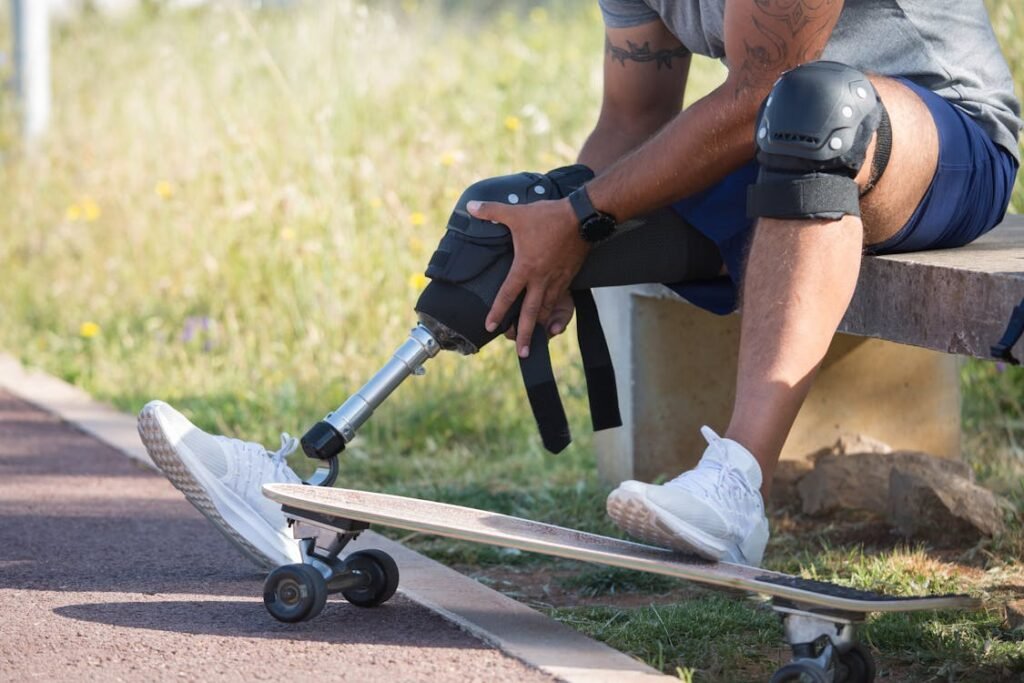
Innovation and the Future of Socket Design
Smart Materials and Dynamic Fit
In recent years, materials used in socket design have taken a huge leap forward. Newer sockets don’t just hold the limb—they adapt to it.
Some sockets now include smart materials that respond to temperature, pressure, and movement. These materials shift slightly to give or tighten, depending on the activity or body changes throughout the day.
This is especially useful for users whose limb volume changes regularly. Instead of adding or removing socks, the socket gently adjusts itself.
This keeps the limb centered, reduces friction, and maintains even weight distribution without extra effort from the user.
We are also seeing the rise of vacuum suspension systems. These systems create a secure seal between the limb and socket using air pressure.
This not only keeps the prosthetic in place, but also improves circulation and reduces movement inside the socket. The result is a more stable, responsive prosthetic that feels like an extension of your own body.
At Robobionics, we’re working to bring these technologies to users in a way that is both affordable and effective.
Our goal is to blend cutting-edge science with real-world reliability so every step feels smoother, safer, and more natural.
Data-Driven Customization
New tools are making it easier than ever to create a socket that fits exactly right. Digital pressure mapping, 3D scanning, and motion capture systems allow prosthetists to see how the limb behaves under real-life movement.
Instead of relying only on touch and visual checks, these tools give clear data—showing where the limb bears weight, where there’s rubbing or gaps, and how forces move through the socket during each step.
This data is then used to refine the socket, sometimes even while the user is still in the clinic.
This personalized approach makes a huge difference. Instead of taking weeks to adjust to a new socket, users often report comfort within the first few days.
It reduces trial and error and helps build trust faster. And when users trust their prosthetic, they move better, train harder, and live more freely.
Long-Term Comfort and Ongoing Care
The Body Changes Over Time
Just like our shoes or clothes, a socket that fits well today may not feel right next year. Life brings change—weight gain or loss, aging, shifts in muscle tone, or changes in walking habits.
These affect how the socket fits and how weight is carried through the prosthetic.
That’s why ongoing support is not optional—it’s essential. A socket is not a one-time solution. It’s a long-term relationship that must grow with the user.
At Robobionics, we encourage regular follow-ups, not just for repairs but for reassessment.
We check how the socket feels, how the user walks, and how their body is adapting. If we notice shifts in posture, new pressure points, or discomfort during specific movements, we adjust the socket to fit those needs. A minor change today can prevent bigger problems later.
Repair, Rebuild, or Replace?
Sometimes a socket simply wears out. Materials break down. Padding thins. The shape may no longer match the user’s limb. When that happens, we assess whether it needs repair, a complete rebuild, or a full replacement.
Repairs can include replacing liners, adjusting trim lines, or reshaping pressure zones. Rebuilds involve re-casting or scanning the limb and making a new socket from scratch.
Either way, the goal is to keep the user comfortable and mobile with as little disruption as possible.
We make it easy to schedule these updates, especially for users in remote areas. Through our partner clinics and mobile service support, help is always close.
And because our prosthetics are locally made in India, turnaround is fast and affordable—often just a few days.
The Real Impact of a Great Socket
More Than Just a Fit—It’s Freedom
When someone gets a socket that fits right, they don’t just move better—they live better. We’ve seen people go from avoiding their prosthetic to wearing it all day.
We’ve seen users regain their jobs, return to school, travel alone, and do things they once thought were out of reach.
It’s not because of fancy features or robotic joints—it’s because of one well-designed part that supports the rest.
The socket is where everything starts. When it fits well, it gives people the foundation to move freely, stand proudly, and live without limits.
A well-designed socket turns a prosthetic from a tool into a true extension of the body. It brings confidence. It reduces pain.
And it brings back the joy of everyday movement—walking down the street, standing in the kitchen, playing with children, or dancing at a celebration.
Looking Ahead
The future of socket design is exciting. Smarter materials, better data, and more user-focused care are changing how we build and use prosthetics.
But even as technology grows, one thing remains constant: the need to listen to each user’s story.
At Robobionics, we don’t just build sockets—we build relationships. We take the time to understand, adjust, and evolve with each person who trusts us with their care.
Because in the end, a socket isn’t just about support. It’s about dignity, confidence, and the freedom to live life on your terms.
Conclusion
The socket is the most personal and powerful part of a lower limb prosthetic. It shapes how weight is carried, how movement feels, and how confident a user can be. A well-designed socket doesn’t just hold the limb—it supports the whole person.
From pressure distribution and alignment to materials and daily movement, every detail matters. When the socket fits well, comfort improves, posture balances, and life becomes easier. It allows users to walk longer, stand taller, and feel more in control of their day.
At Robobionics, we believe that every user deserves a socket that works with them, not against them. Through precise design, ongoing care, and real understanding, we build sockets that support not just motion—but freedom.
If you’re looking for a more comfortable, stable, and personalized prosthetic experience, we’re here to help you take the next step—literally and confidently.



